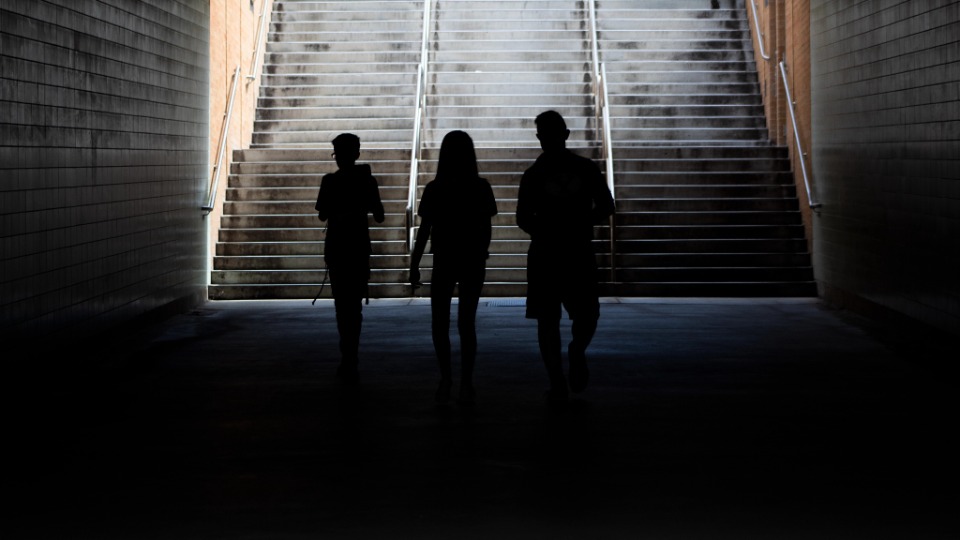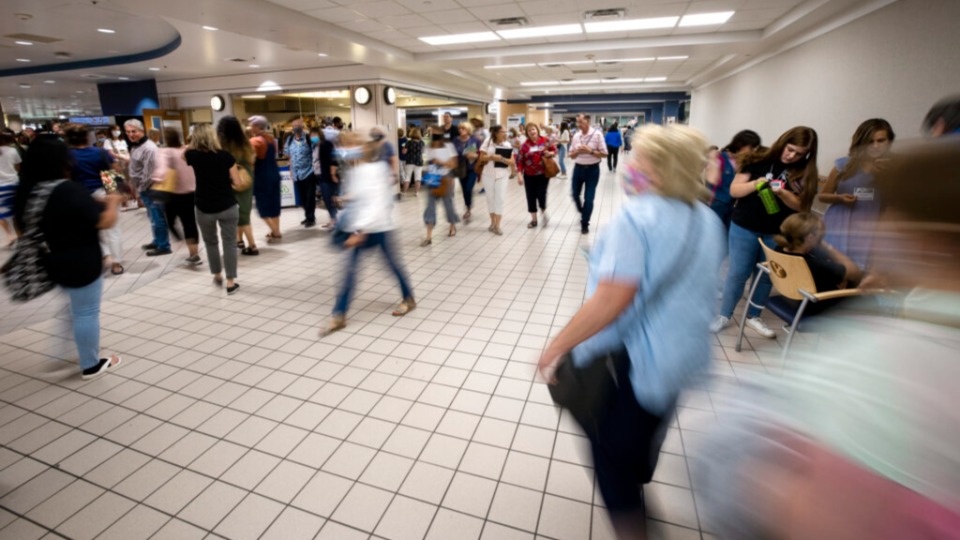
This story appears here courtesy of TheChurchNews.com. It is not for use by other media.
By Rachel Sterzer Gibson, Church News
A popular narrative about suicide among Utah youth — that The Church of Jesus Christ of Latter-day Saints or its culture is driving higher rates — is not supported by data, social scientist Michael A. Goodman explained to a BYU Education Week audience.
However, even though being religious statistically correlates to a lower suicide risk, Goodman told his listeners: “We have a lot of work to do. Any suicide is too many.”
Goodman, an associate professor at BYU, holds a PhD in marriage and family studies. He and a few of his colleagues at BYU — Sam A. Hardy, W. Justin Dyer and Mark D. Ogletree — are collecting information from over 2,000 adolescents and their parents over a 10-year period for a study titled Family Foundations of Youth Development.
Each researcher took a day presenting at Education Week for a class called “Youth of the Noble Birthright: What Social Sciences Data Tell Us About Latter-day Saint Youth.” In his presentation, Goodman delved into the data surrounding Latter-day Saint youth and suicide and discussed what is real, what is false, and how individuals, groups and others can help.
The narrative that has been circulating in recent years among local, national and social media implies that being a Latter-day Saint youth — or specifically an LGBTQ Latter-day Saint youth — is a recipe for suicidality (having thoughts, feelings or desires for suicide).
Goodman said he believes those sharing the narrative are largely well-intentioned. “They’re trying to help,” Goodman said. However, the narrative itself, true or not, can potentially increase the risk of suicidality.
“If you tell somebody who’s hurting and in pain: ‘Your people hate you. You should be ashamed. They think you’re horrible. They think you’re irredeemable. You have no future with them. Your family is going to desert you’ — if you share that with someone who’s in pain, is it a wonder why they’re going to struggle more?” Goodman said.
“We need to get rid of the false narrative, not because we want to defend the Church or to defend Utah or defend anything, but because those false narratives create increased suicidality, increased risk.”
The point is not to use statistics as a weapon, Goodman explained. But by showing reality on an aggregate basis, Goodman and his colleagues, who have been researching the social science data, want to offer hope on an individual basis.
Lived Experiences
Goodman began his remarks by sharing the experiences of four Latter-day Saint youth who identify as LGBTQ.
“Suzie” is lesbian and desires to live according to the restored gospel. She is depressed, anxious and suicidal but doesn’t blame the Church for her pain. “Sam” is gay and wants to live according to his sexual orientation. He is depressed, anxious and suicidal and blames the Church for his pain. “Janie” is transgender and plans on staying on the covenant path but is depressed, anxious and suicidal. “Jim” is bi-sexual and desires to live according to his sexual orientation as well as the restored gospel. He is not depressed, anxious or suicidal, and he wants to stay covenant connected but is not sure how.
Behind statistics are individuals whose experiences are distinct, authentic, and deserving of being heard and understood, Goodman said.
Although statistics help Goodman and his colleagues paint an overall picture, “that doesn’t mean an individual doesn’t have a difficult situation with the Church,” Goodman explained.
Don’t deny someone else’s lived experience, Goodman said, but also don’t take that experience and pretend that it matches reality for the majority.
Even as he showed statistics and averages, Goodman warned his listeners: “Don’t whitewash individuals. Let’s use the data to help us learn how we can best serve and help real individuals.”

What Is the Data?
Utah does, in fact, have a higher adolescent suicide rate than the national average. The statistics are troubling, Goodman said. Suicide is the second leading cause of death for people ages 10–17 in the state, and Utah has the fifth highest suicide rates in the nation. Roughly 40% of suicide deaths in Utah involved people — either the victim or a parent — associated with the Church.
“We should look at this, and no matter what the causes, we should say we’ve got to do something better than we’re currently doing,” Goodman said.
Many look at Utah’s high suicide rates and connect it with the state’s large Latter-day Saint population. Few, however, actually contextualize the information, Goodman said.
With the exception of one or two outliers, all of the states with the highest suicide rates are within the same geographic area, which researchers call “the suicide corridor.” Utah is “smack dab in the middle of the suicide corridor,” Goodman explained, where the suicide rates are all about double the national average.
Goodman and his colleagues looked closely about what correlates, or relates, to higher or lower suicidality within the suicide corridor. “That information is crucially important because it can help us as we try to figure out in the aggregate how to help.”
The states within the suicide corridor share many characteristics associated with high suicide rates, including race (Caucasian and Native Americans are higher risk while minorities such as Hispanics or Blacks are lower risk), rurality, high elevation and high gun ownership.
Other factors that correlate, or coincide, with higher suicide rates include low income, low education, poor mental health, living in single-parent households and sexual minority status.
Religion, however, showed less risk of suicide. Consistently, the research shows that religion in general, and the Church specifically, are protective against suicidality, he said.
“Again, that doesn’t mean that individuals don’t have a difficult situation with the Church or that that contributes to that individual’s experience,” Goodman said.
Goodman and the other researchers gathered information from seven data sets (from the Centers for Disease Control, U.S. Census Bureau, U.S. Religion Census, BYU’s Geospatial Center Data and others) and looked at 1,500 counties nationwide to study suicidality. “We learned really quickly that we had to separate out the suicide belt from the non-suicide belt because they didn’t behave the same.”
Taking data from the Church, they looked at how many Latter-day Saint congregations were in a given county and compared that to suicide rates.
“The area with by far the strongest Church presence has by far the lower suicide rates.”
For Latter-day Saint youth in Utah, the number of youth ages 10–17 who experienced suicidal ideation or had made suicide attempts was less than half of the state’s total.
After looking at the data, Goodman and his colleagues wondered if that was also true for minority groups, such as those who identify as LGBTQ.
Religion and LGBTQ adolescent suicidality is a complicated story, Goodman said. Some LGBTQ experience tremendous benefits from religion such as increased sense of self, acceptance of others, incorporation of religious values and greater social support. Others, however, experience feelings of inadequacy, religious guilt, depressive symptoms and social strain.
Goodman and his colleagues on the Family Foundations of Youth Development longitudinal study have found that LGBTQ adolescents have much higher suicidality than their heterosexual peers: where 15% of heterosexual youth have experienced suicidal ideation, 43% of LGBTQ adolescents have experienced suicidal ideation.
They looked at LGBQ suicidality (there is not enough data on transgender suicidality to make statistical inference) and found that 44% of Latter-day Saint LGBQ individuals experienced suicidality compared to 47% of those in other religions and 77% of those who claim no religious denomination or are atheist or agnostic.
“If that doesn’t scare you into wanting to help, I don’t know what would,” Goodman said.
Some of the strongest correlates to suicidality among LGBQ individuals were experiencing prior suicidality, feeling abandoned by God, experiencing a father’s verbal hostility and experiencing depression.
When LGBQ individuals felt loved or supported by their church members, “that was very protective,” Goodman said.
Overall, LGBQ individuals who felt religion was important to them were 50% less likely to have felt suicidal.
One of the greatest protectors against suicidality? Feelings of closeness and strong relationships with others.
Latter-day Saint LGBTQ individuals have lower suicide rates than the general LGBTQ population and most other religious LGBTQ populations. One possible reason is strong family and social support, which is crucial, Goodman said. “It just so happens that Latter-day Saint LGBTQ have the highest family support rates.”
Goodman said he realizes that fact is contrary to the narrative and contrary to some individuals’ experiences. “But in the aggregate, as we look and we have good data, if you’re going to be a sexual minority, if that’s part of your reality, you will have the most family support in the Latter-day Saint family. And in Utah — because we can only speak to Utah with this — you’ll have the lowest bullying rates, as well.”

Therefore, What?
Goodman introduced his listeners to an interpersonal theory regarding suicide. It’s an academic theory, Goodman explained, that is “pretty well substantiated” from his and his colleagues’ findings.
There are some individuals who feel “thwarted belongingness,” or that they don’t belong and are isolated. There are those who feel like a burden, or “I’m more of a problem than I’m worth.” For those that feel both — that they don’t belong and that they’re a burden — it creates what they call suicidality, or thoughts, feelings or desires of suicide, Goodman said. If both of those feelings are combined with capability — meaning access to a gun, opioids, and so on — “that’s where you get the lethal suicide attempts,” Goodman explained.
As individuals who strive to love Heavenly Father, to love the Savior and to love their neighbors, members of the Church “should work on helping people feel that they belong and are of worth,” Goodman said. “That doesn’t mean that you have to agree with everyone. That doesn’t mean that they have to agree with you. Can we be Christian enough to love each other even if we disagree with each other? We should be working to make every person understand [his or her] worth.”
Those who want to help may or may not be able to control much about a struggling individual’s situation, but everyone has the capability to help others feel loved and of worth, Goodman said.
How to Help
“It’s important to recognize signs of people who are struggling,” Goodman said, and he listed several possible indicators:
- looking for a way to kill themselves
- talking about feeling hopeless or having no reason to live
- talking about feeling trapped or feeling unbearable pain
- talking about being a burden to others
- increasing use of alcohol or drugs
- giving away personal items for no reason
- acting anxious or agitated or behaving recklessly
- withdrawing or isolating themselves
- showing rage or talking about seeking revenge
- displaying extreme mood swings
“These are possible warning [bells] that should go off in your head,” Goodman said.
Those who recognize the signs can help struggling individuals by doing three things: Ask, Care, Tell — or ACT.
“Your job isn’t to provide professional counseling to people who are struggling,” Goodman said of the acronym, “but every one of us can do this.”
First, if an individual sees someone struggling, ask them how they are doing and acknowledge their experience or feelings.
Second, “show them that you care.”
Third, especially in cases where the struggling individual is showing increasing risk or desperation, tell someone. “Don’t stay silent,” Goodman said. “If they’ll allow you to help, great. Guide them to somebody who can help them. And if they won’t allow you to, do it anyway. Let them be mad at you.”
Goodman then provided a list of available resources:
- National Suicide Prevention Lifeline, 1-800-273-TALK (8255)
- Crisis Text Line (text HOME to 741-741 for free, 24-hour support)
- SafeUT app (connects users directly with a crisis line)
- Family Acceptance Project, familyproject.sfsu.edu
- Suicide Prevention Resource Center, www.sprc.org
- National Alliance of Mental Illness, www.nami.org
- Parent Resource Program, www.jasonfoundation.com/community/
- Resources on suicide from The Church of Jesus Christ of Latter-day Saints: www.churchofjesuschrist.org/get-help/suicide
- Resources for LGBT Latter-day Saints: www.mormonandgay.churchofjesuschrist.org/
In conclusion, Goodman said, “don’t forget Heavenly Father lives and is the greatest source of help we can give ourselves and others.”
Copyright 2021 Deseret News Publishing Company